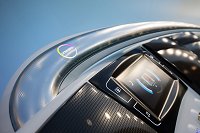The car cockpit becomes individual and functional
21.02.2018
The development of film technologies for car interiors has made great progress in recent years. This is confirmed by the lectures held at the "Folien+Fahrzeug" conference with an accompanying exhibition on February 6 and 7, 2018 in Hanover, Germany.
"Trends such as autonomous driving, networking and individualization pose entirely new challenges, but also offer great opportunities for the use of polycarbonate and thermoplastic polyurethane films," explains Dirk Pophusen, film specialist at Covestro and technical director of the conference.
 Seamlessly integrated 3D displays in large format
Seamlessly integrated 3D displays in large format
The number of displays and touchscreens in car interiors will increase drastically due to the progressing digitization and networking (connectivity) as well as the trend towards autonomous driving. Large-surface, three-dimensional screen designs that can be seamlessly integrated into the surfaces of instrument panels, center consoles, door and seat panels are a current trend.
What is also important is a high-contrast image and clearly legible information – even in adverse lighting conditions. Displays must not reflect light or dazzle (anti-glare). Covestro has developed Makrofol® HF, a two-stage curable film that can be formed over a large area and is especially suitable for the edging and trimming of such displays. Depending on the optical requirements, they can be adjusted from high gloss to fine matt and are resistant to chemicals and scratches.
Touch displays with a filigree 3D surface are a new application for Makrofol® films. They enable the driver to control the display and its functions simply by touching them without having to turn their eyes away from the road. This improves road safety.
Versatile possibilities with TPU films
 In addition, Covestro will also be presenting the wide range of possible applications for films based on thermoplastic polyurethane (TPU) in car interiors. Oliver Hennig, another Covestro film expert, will talk about the role they already play today and what opportunities are opening up for them in this respect in his presentation, "The use of TPU films in vehicles – silent heroes".
In addition, Covestro will also be presenting the wide range of possible applications for films based on thermoplastic polyurethane (TPU) in car interiors. Oliver Hennig, another Covestro film expert, will talk about the role they already play today and what opportunities are opening up for them in this respect in his presentation, "The use of TPU films in vehicles – silent heroes".
Platilon® TPU films from Covestro are present – although not always visible – in many parts of the car interior, such as textile laminates from roller blinds for sunroofs, as air chambers for lumbar supports of car seats or as foam shrouds for noise reduction components.
Decorative and lighting effects with flexible electronics
A new promising application is the so-called "flexible electronics". The elastic TPU films are equipped by film processors with electronic functions such as traces or sensor elements. "LEDs can also be integrated. The resulting film build-ups can be formed into geometrically highly complex decorative parts that provide lighting effects," says Hennig.
Flexible electronics based on TPU films could be used in electric vehicles for panel heating of large surface areas in car interiors and could replace the expensive exhaust air heating of traditional combustion engines. Hennig: "With their extreme flexibility and good adhesion to textiles, TPU films offer the best prerequisites for integrating the required conductor path electronics into door panels, for example."





































